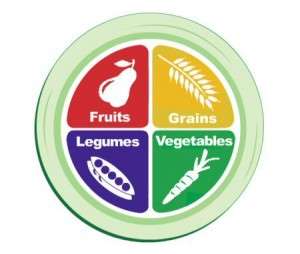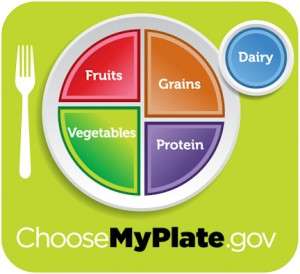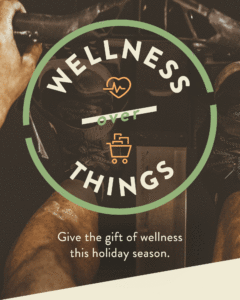By now you’ve probably seen that the USDA has come out with it’s latest rendition of the food guide pyramid- MyPlate. Its release last week led to some buzz (at least from my perspective on facebook and twitter), and I have already seen several articles written on the pros and cons of this new model, such as in The Boston Globe and The Physicians Committee for Responsible Medicine (PCRM). Here’s my take on the USDA’s latest guidelines:
The Pros:
- Half the plate is produce; the biggest portion on the plate is even vegetables!
- There are several plant foods listed under proteins
- Vegetarian diets are (finally) listed as able “to meet all the recommendations for nutrients”!
- The layout is straightforward and much less ambiguous than the last pyramid
The Cons:
- A place reserved for dairy! Many epidemiological studies strongly correlate dairy intake with increased rates of cancer, type 1 & 2 diabetes, and Dr. Campbell’s research even identified the milk protein casein as being “one of the most potent carcinogens ever discovered”. Why on earth is the breast milk of another species an essential food group for humans, especially weened adult humans?! See the part on subsidies in the PCRM article listed above.
- There’s still lots of emphasis on animal protein sources in the protein section, and none of the risks associated with it are mentioned (increased risk of heart disease, stroke, many cancers, and diabetes).
- Under the vegetarian diets question it states “Consuming enough plant foods to meet calcium needs may be unrealistic for many”. Unrealistic? There is a day’s worth of calcium in one cup of cooked broccoli! Bok Choy has even more! How, then, do all the other primates (or all the herbivores for that matter) get enough calcium to survive without drinking cow’s milk?
- The grains section lists both whole grains and refined grains, and suggests making sure only half of the grains you eat are whole grains. Refined grains are high glycemic and very low in nutrients (all the fiber, vitamins/minerals, and antioxidants are stripped out with all the processing). And refined grain-based foods invariably come in a package full of fat, sugar, salt, and plenty of chemical preservatives and flavors (take corn chips and/or donuts for example).
So, even though this plate is a huge step in the right direction with its increased emphasis on plant foods, there are still many things that could be improved. If you’d like a better set of guidelines to plan your diet around, try the Power Plate, also from PCRM, shown below. Hmmm, I wonder where the USDA got the idea for their new model….

P.S. Dr. Neal Barnard compares the two plates here.




Hi Derek,
No worries! That looks like a good guide. The blackstrap molasses is quite tasty when dissolved in hot black tea – hot water would probably work too. If you put too much in it is too sweet.
Keep representing
Matt
Hi Derek,
interesting article. Although I think I should point out that 1 cup of broccoli has about 74mg of calcium and the US RDA is 1000 mg so it is less than 1/10th the RDA ( I live in the UK and here it is 800mg ). I would recommend blackstrap molasses (has to be blackstrap) for calcium.
Thanks
Hi Matt,
Thanks for the correction! I forget where I read the fact about broccoli, but you’re absolutely right – I messed up the calcium concentration somewhere. In checking it out I found a good calcium guide here.